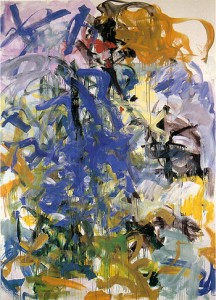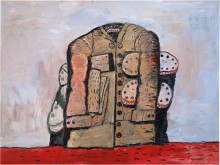Joan Mitchell
Before, Again IV 1985

© Estate of Joan Mitchell. Reproduction of this image, including downloading, is prohibited.
Audio Description (02:18)
Full Audio Transcript (Expand)
Before, Again IV
In 1985, after having received a cancer diagnosis, Joan Mitchell painted the Before, Again cycle. At a little over nine feet tall and five and a half feet wide, Before, Again IV is an abstract oil painting on canvas composed of networks of wide, squiggly bands that range from sharp and clean-edged to smudged to dripping as if caught in the rain. They layer over each other and layer again, going every which way, in dark blue, pale blue, golden-orange, bubblegum pink, tan, gray, kelly green, and just a few spots of vibrant fire engine red. There are variations on these hues where a band was painted over another one that was still wet, inviting unique colors to emerge from these smudges. The addition of white painted marks plays with the viewer’s perceptions. At times, it becomes unclear whether some creamy off-white portions are made by white paint applied over other colors or they are actually small hints of white primed canvas peeking through from between the undulating lines. Only some of the wavy lines are short and crisp. Most are long and flowing, with clusters of bends and curves that seem as if the artist’s arm must have made large, sweeping gestures to bring paint to canvas.
The dominant colors are blue, green, gray, and orange. Pink appears almost exclusively in the upper left corner with faint touches of it at the lower left. The upper right corner is unpainted. A noodly tangle of gold floats near the upper middle portion. One long, golden ribbon waves out behind it like a scarf caught in a breeze while the tangle streams toward the left. Most of the painting is deeply layered. Sometimes a dark color like kelly green winds its way over a golden streamer. At other times, a pale pink glides its way down a darker green like passing clouds. It would not be unusual to wonder, at times, which colors are painted on higher layers and which are below. The waving, looping quality of the thick bands of color can make it hard to tell in which order the colors were painted on. And because there are no truly straight lines on this canvas, there is a sense that the painting is moving while the viewer remains in place.
Joan Mitchell is considered part of the “second generation” of abstract expressionists, and one of the few women associated with the conventionally masculine action painting movement. Mitchell’s large, gestural, “all over” paintings are infused with light and movement, often referencing landscapes or the natural world. “My paintings repeat a feeling about Lake Michigan, or water, or field…it’s more like a poem…and that’s what I want to paint,” Mitchell said. The periods of Mitchell’s work were catalyzed by life events, relationships, and experiences. Before, Again IV comes from the late part of Mitchell’s career, after she was diagnosed with cancer. During this period, she made some of her most experimental work. Mitchell thought of painting as a form of transcendence and nurturing, and as the antithesis of death.
Redefining Feminism in Modern Art
Mitchell’s towering works and abstractions, like Before, Again IV, are charged with a sense of place and of the present. This work was made at a time of great personal struggle in Mitchell’s life, as her battle with cancer had reduced her physical capabilities significantly. However, she continued to paint her large-scale works and used color in the best way she knew: as a reminder of place, memory, and emotion.
Writings and reflections on Mitchell’s career have converged around her advancement of the feminist movement through her attempted escape from the patriarchy, with her paintings labeled as reflections of her so-called “singular struggle” of sexism. She is applauded by contemporary feminists for her success in the male-dominated field of Abstract Expressionism, even though she saw most of her female counterparts as rivals rather than friends. Similar to many other female artists at the time, she wanted to distance herself from politicized feminism and just wanted to make her art.
—Irmak Ersoz ‘24






